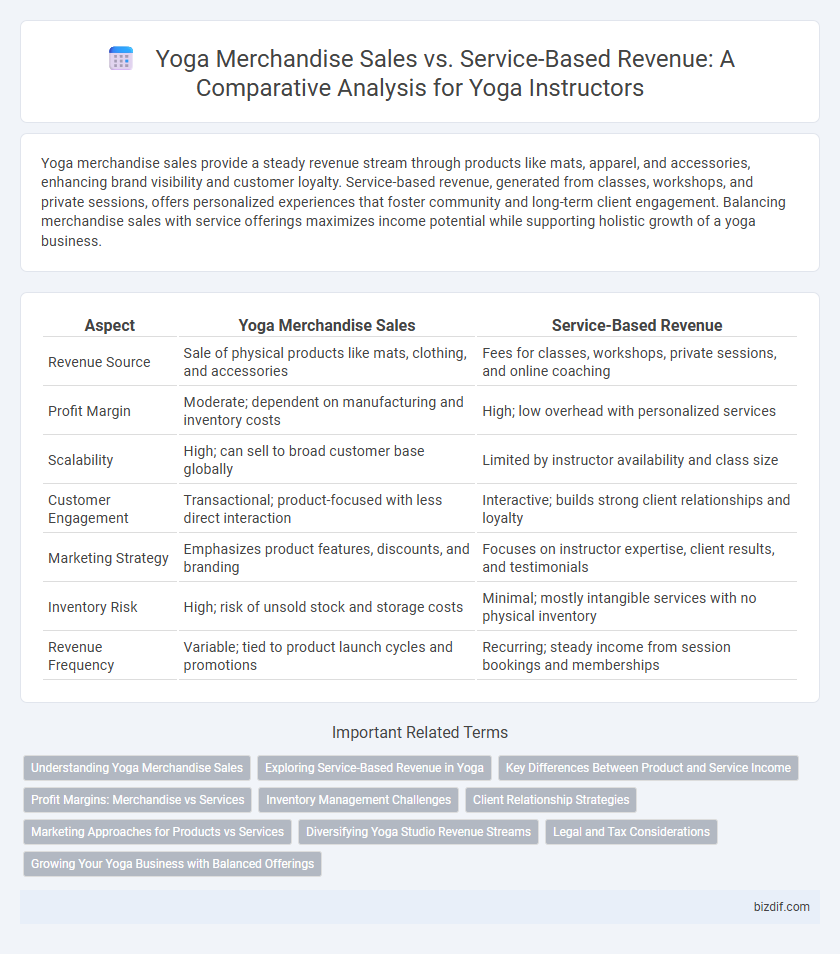Yoga merchandise sales provide a steady revenue stream through products like mats, apparel, and accessories, enhancing brand visibility and customer loyalty. Service-based revenue, generated from classes, workshops, and private sessions, offers personalized experiences that foster community and long-term client engagement. Balancing merchandise sales with service offerings maximizes income potential while supporting holistic growth of a yoga business.
Table of Comparison
| Aspect | Yoga Merchandise Sales | Service-Based Revenue |
|---|---|---|
| Revenue Source | Sale of physical products like mats, clothing, and accessories | Fees for classes, workshops, private sessions, and online coaching |
| Profit Margin | Moderate; dependent on manufacturing and inventory costs | High; low overhead with personalized services |
| Scalability | High; can sell to broad customer base globally | Limited by instructor availability and class size |
| Customer Engagement | Transactional; product-focused with less direct interaction | Interactive; builds strong client relationships and loyalty |
| Marketing Strategy | Emphasizes product features, discounts, and branding | Focuses on instructor expertise, client results, and testimonials |
| Inventory Risk | High; risk of unsold stock and storage costs | Minimal; mostly intangible services with no physical inventory |
| Revenue Frequency | Variable; tied to product launch cycles and promotions | Recurring; steady income from session bookings and memberships |
Understanding Yoga Merchandise Sales
Yoga merchandise sales encompass products like mats, apparel, blocks, and straps that enhance practice quality and brand loyalty among practitioners. These tangible items generate direct income and provide marketing visibility beyond in-studio sessions, creating a continuous revenue stream. Understanding inventory management, customer preferences, and seasonal demand is crucial for maximizing profitability in yoga merchandise sales.
Exploring Service-Based Revenue in Yoga
Service-based revenue in yoga primarily derives from guided classes, workshops, and personalized coaching, which foster community and client retention more effectively than merchandise sales. High-quality instruction and specialized training sessions command premium pricing, enhancing profitability beyond one-time product purchases. Offering virtual and in-person services expands reach, creating scalable revenue streams that align with the growing demand for personalized wellness experiences.
Key Differences Between Product and Service Income
Yoga merchandise sales generate product-based income through tangible items such as mats, apparel, and accessories, offering consistent and scalable revenue streams. Service-based revenue from yoga instruction relies on personalized experiences like classes, workshops, and private sessions, which often involve variable scheduling and direct client engagement. The primary distinction lies in merchandise providing inventory-dependent income, while service income is driven by time, expertise, and client relationships.
Profit Margins: Merchandise vs Services
Yoga merchandise sales often yield higher profit margins due to lower production costs and the ability to scale inventory, compared to service-based revenue streams like classes or workshops that require ongoing instructor time and facility expenses. Physical products such as mats, apparel, and accessories can be marked up significantly, generating consistent passive income. In contrast, service-based revenue is tied directly to client attendance and retention, limiting scalability and often resulting in thinner profit margins.
Inventory Management Challenges
Managing inventory for yoga merchandise sales presents unique challenges compared to service-based revenue streams, requiring precise stock control to avoid overstocking or stockouts that can disrupt cash flow. Physical products such as mats, apparel, and accessories demand accurate demand forecasting and supplier coordination, unlike services that rely primarily on appointment scheduling and instructor availability. Effective inventory management systems integrated with sales platforms help optimize stock levels and ensure a balanced focus between tangible product offerings and service delivery revenue.
Client Relationship Strategies
Yoga merchandise sales provide a tangible product line that enhances brand visibility and offers clients convenient access to essential yoga gear like mats, apparel, and accessories. Service-based revenue stems from personalized instruction, workshops, and membership programs tailored to deepen client engagement and foster long-term loyalty. Effective client relationship strategies combine regular communication, feedback integration, and exclusive offers to harmonize merchandise sales with service-based income, creating a holistic and sustainable yoga business model.
Marketing Approaches for Products vs Services
Marketing approaches for yoga merchandise sales emphasize visual content showcasing product benefits, leveraging social media platforms, and utilizing influencer partnerships to drive direct purchases. Service-based revenue in yoga instruction relies heavily on building trust through client testimonials, personalized communication, and offering trial classes or workshops to demonstrate expertise. Product campaigns focus on tangible features and discounts, while service marketing targets community engagement and long-term client relationships.
Diversifying Yoga Studio Revenue Streams
Diversifying yoga studio revenue streams by integrating yoga merchandise sales alongside service-based offerings significantly boosts overall profitability. Retailing items such as yoga mats, apparel, and wellness products taps into existing client loyalty, generating consistent supplementary income. This balanced approach reduces reliance on fluctuating class attendance and enhances long-term financial stability for yoga studios.
Legal and Tax Considerations
Yoga merchandise sales generate product-based revenue subject to sales tax regulations and inventory management requirements, while service-based revenue from classes and workshops typically involves income tax and potential licensing considerations. Proper classification of revenue streams ensures compliance with tax codes such as sales tax on tangible goods and service tax exemptions, depending on jurisdiction. Maintaining detailed records for merchandise transactions and service receipts is critical for accurate tax reporting and minimizing legal risks in yoga businesses.
Growing Your Yoga Business with Balanced Offerings
Balancing yoga merchandise sales with service-based revenue creates a diversified income stream that strengthens your yoga business. Offering quality yoga mats, apparel, and accessories complements class packages and private sessions, enhancing customer engagement and brand loyalty. Integrating online merchandise stores with on-demand classes expands reach, increases sales opportunities, and supports sustainable growth.
Yoga Merchandise Sales vs Service-Based Revenue Infographic

 bizdif.com
bizdif.com